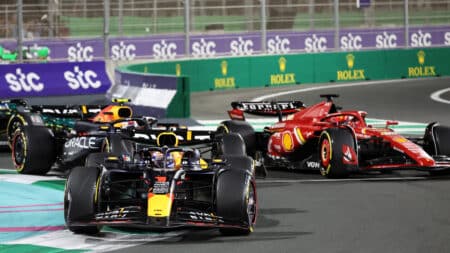
Which Red Bull will show up in Jeddah? - What to watch for at Saudi GP
Can Red Bull rebound from its poor Bahrain showing? And will it be Piastri or Norris leading McLaren's charge? Here's the five themes to watch for at the Saudi Arabian GP
OK, so it looks like we are not going to get the mooted twin turbos or turbo V8s – but we will almost certainly be getting 1000bhp+ versions of the current engines for the season after next. That’s how it’s hanging at the moment, anyhow.
To go with them we’ll probably be seeing wider tyres – on the rear at least – probably of lower profile. It’s likely the cars will also be regulated to be shorter in wheelbase in an attempt to make them more demanding to drive.
They almost certainly won’t look like Ferrari’s striking F1 concept car (or the virtual reality and beautiful Red Bull X1 of a few years ago). Short of insisting upon a spec body, trying to regulate-in beautiful aesthetics would be doomed to failure; the most aerodynamically efficient design within whatever body surface template you laid down would always tend towards ugly. Nature just doesn’t have a good eye for beauty with regard to airflow over a downforce-generating open-wheeled car. Or rather she does, but once you’ve put in place restrictions to prevent designs that would require the drivers to wear g-suits – the Red Bull X1 could be seen as the logical evolution of the gorgeous Lotus 79, for example, had regulation not interrupted – then she doesn’t.
So while the Ferrari concept car looks like how, 30 years ago, we would have expected F1 cars to have looked by now, that need for cars that can actually be raced by human beings amid the exponential increase in aerodynamic knowledge is why F1 cars of today do not to the casual eye look any more advanced than those of three decades ago. Up to that time the shapes were very visually evolving into ever-more advanced forms.
Think back 30 years to a McLaren-TAG, say, and compare it to cars of today; it doesn’t look so very different. Then go back another 30 years to a Maserati 250F… By the late ‘70s, with the engines in the back, wings and ground effect venturis they were getting close to the theoretical ideal in terms of concept. Everything since has been about keeping the performance potential of that concept contained within sane limits.
So let’s be realistic; the cars aren’t about to look dramatically different. But from 2017 they are going to be significantly faster. Let’s forget for a moment the question of why there is this perceived urgency to make significant changes so soon after the introduction of the new formula and consider instead what their effect might be.
One thousand horsepower is a nice headline figure but even without the proposed regulation tweaks, the current Mercedes engine might even have that figure within its normal development sights. Last year it was believed to have been delivering circa 860bhp, this year probably in excess of 900. However, the regulators are aiming to make that four-digit threshold more achievable by everyone – by increasing the fuel flow limit from its current 100kg per hour to something more like 125kg/hour. The current 100kg maximum fuel load will almost certainly stay. So they will be more powerful but will still not be allowed to use more fuel in total.
How would that be possible? By the normal advances in efficiency – in both the engine and the energy recovery systems. Already last year, it was possible for some of the Mercedes-engined cars at certain tracks to have made do with just 90kg. Furthermore, this year variable inlet trumpets are back (they were banned during the V8 era), allowing the natural holes in the engines’ torque curves to be filled more effectively by mechanical means. This will release some of that burden from the electrical systems – in turn allowing them to deliver more power elsewhere at no extra cost in fuel.
Increasing the fuel flow by 25% would make it advantageous to run the engines closer towards the current 15,000rpm regulation limit. At the moment they run only up to about 12,500rpm as thereafter they are strangled by the fuel-flow limit. Running higher revs would allow the energy recovery systems, even without the expected advances, to harvest more power. Higher revs would generate more heat for the ersH to work with while likely higher end-of-straight speeds would mean more braking and therefore more recovered energy from the ersK. Fatter rear tyres would mean greater braking potential from the rear axle, further increasing the ersK harvest rate. It would all help drive the technology along even harder, while still giving us faster, more spectacular cars. It’s the F1 strategy group’s response to the worrying trend in viewing figures and, at some tracks, attendances.
It’s all very laudable. But, as with any change, it’s going to bring associated costs. While the strategy group has been investing time in devising these changes it’s still not arrived at anything vaguely like a solution for the economic crisis facing the smaller teams. As things stand, Force India, Sauber and Lotus might not need to worry about the 2017 cars…

Can Red Bull rebound from its poor Bahrain showing? And will it be Piastri or Norris leading McLaren's charge? Here's the five themes to watch for at the Saudi Arabian GP

McLaren's breakthrough in a near-four-year-old ruleset shows F1 rules convergence is a myth – just like Sebastian Vettel, Red Bull and Renault did in 2013, writes Mark Hughes

Madrid finally has a consortium to build the new Formula 1 circuit that will host the 2026 Spanish GP

Helmut Marko caused a stir after the Bahrain GP with his worries that Max Verstappen could leave Red Bull early. But how real are those fears?